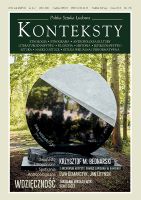Żółta plamka
Yellow Spot/Macula
Author(s): Maria PoprzęckaSubject(s): Cultural Essay, Theory of Literature, Sociology of Literature
Published by: Instytut Sztuki Polskiej Akademii Nauk
Keywords: Yellow Spot/Macula; Proust; À la recherche du temps perdu;
Summary/Abstract: The article deals with a fragment of La Prisonnière, the fifth volume in the À la recherche du temps perdu series by Marcel Proust. The fragment in question pertains to the demise of Bergotte, a writer who dies in a museum showroom while facing View of Delft, an oil painting by Vermeer van Delft, and has been the topic of numerous analyses and reflections by Proust’s biographers and researchers specialising in visual arts. The polemics focus on several elements of the scene which takes place in Jeu de Paume (Paris) at an exhibition of Vermeer, admired by both Proust and the fictional writer Bergotte. The first – typically biographical – controversy pertains to the connection between the text of the volume and the actual visit paid by the gravely ill Proust at the Vermeer exhibition. Bergotte is often perceived as the writer’s alter ego and his death in front of “the most beautiful painting in the world” as an anticipation of Proust’s demise. Evidence of the overlapping of biographic reality and literary fiction is the controversy pertaining to the circumstances of the origin of the scene of Bergotte’s death (including the supposition that the description in question was dictated by the writer during the last hours of his night of agony). Much controversy was also stirred by the localisation on the painting of a “small piece of a yellow wall” (le petit pan de mur si bien peint et jaune), intrusively returning in Bergotte’s antemortem delirium. Generally, the discussion was acknowledged to be barren, although it was revived for popularisation purposes upon the occasion of a large-scale monographic Vermeer exhibition at Rijksmuseum in Amsterdam (spring 2023). The polemic involving several outstanding historians of art concerns not so much the presence or absence of the celebrated piece of wall but the Proustian ritual of seeing, the “modern gaze” that transforms the reality of the painting into its own fiction (Hans Belting). Within the context of those reflections the article stresses the fact that Bergotte’s gaze was predominantly that of a dying person. Proust entrusted the description of the writer’s agony to an eye impaired by a stroke which affected the yellow spot – the most sensitive spot on the retina. The phantasmagorical yellow hue of the glowing spot – regardless of its true nature – is a mere shred of fleeting and indistinct hallucinations caused by agony. The inclusion of the famous scene from the novel into a maladic discourse does not aim at its medicalization. Stressing the physiological, pathological character of Bergotte’s death does not constitute its trivialisation; on the contrary, it makes it possible to bring out more strongly the epiphanic character of the scene of the onset of the writer’s illness and his death.
Journal: Konteksty
- Issue Year: 340/2023
- Issue No: 1-2
- Page Range: 405-411
- Page Count: 7
- Language: Polish
- Content File-PDF

